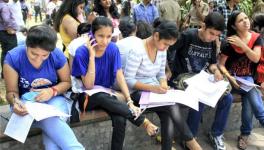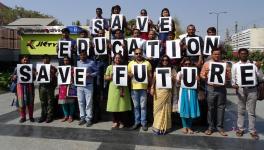Budget '23: Scheme for SC/ST Girl Students Dropped, Misguided Focus on E-learning
Kolkata: The Narendra Modi government has quietly discontinued a scheme to incentivise education of backward class girl students, which was conceptualised and introduced during the tenure of the first United Progressive Alliance (UPA) government. Announced by then Finance minister P Chidambaram, the scheme was called the National Scheme of Incentive to Girls for Secondary Education (NSIGSE).
Moreover, in the Union budget 2022-23, there is a 30% drop in the allocations for scholarships for scheduled caste (SC), scheduled tribe (ST) and other backward classes (OBC) students compared to the last financial year.
In the context of the education-related proposals, an apex organisation of school teachers has called out the absence of a concrete action plan to enable school students to overcome the setback suffered in the three COVID-19 waves. There is also a lack of a mechanism to help students cope with the burden of higher classes once they get promoted under the Right to Education (RTE) Act. The teachers' body opines that the proposals highlight the government's over-eagerness to emphasise e-learning/digitalisation at the cost of conventional schooling and without addressing inadequacies. The immediate need, in their assessment, is to launch in the interest of school students a six-month bridge course programme on a pan-India basis.
Scheme For SC/ST Girl Students Discontinued
The incentive scheme, launched in May 2008 and now discontinued, was an extension of the Kasturba Gandhi Balika Vidyalaya scheme under which 1,000 residential schools for SC, ST and OBC girl students were opened in 2006-07, for which initially Rs 128 crore was provided. A further Rs 172 crore was committed later. At the time, Chidambaram had said, "I propose to provide a further incentive to the girl child who passes the VIII standard examination and enrols in secondary school. A sum of Rs 3,000 will be deposited in her name, and she would be entitled to withdraw it on reaching 18 years of age."
The objective was to incentivise girl students who passed class VIII to complete education up to the secondary school stage because of a higher dropout rate due to compelling socio-economic circumstances.
A reference to several documents clarifies that discontinuation of the incentive was on the Centre's agenda for the past three years or so. Despite that, due to pressure groups, the department for school education and literacy, which administered the scheme, was waiting for an opportune moment. However, allocations to the scheme were gradually reduced, which dropped in four years to a nominal Rs one crore from the high of Rs 320 crore.
When Lok Sabha member from Villupuram in Tamil Nadu, D Ravikumar, urged Education Minister Dharmendra Pradhan to continue the Rs 3,000/year incentive a few months back, Pradhan told him he was implementing the diktat of the expenditure finance committee of the Finance ministry's department of expenditure.
Ravikumar informed NewsClick that the scholarship scheme that has been subjected to a 30% allocation axe is the one for pre-matric SC and OBC students. The demands for grants of the department of social justice and empowerment show the allocation at Rs 500 crore from Rs 725 crore for the current financial year. The appended note informs that the provision is for two sub-schemes – one for SC students and the other for children of parents engaged in "unclean and hazardous occupation."
It is meant for class IX and X students and is intended to minimise dropout, "especially in the elementary to the secondary stage." As per informed quarters, Parliament members who represent constituencies with a higher concentration of SC/ST and OBC students would oppose the cuts at the discussion stage.
Needless Thrust on Digitalisation/E-Learning
In the context of the 2022-23 budget proposals and the "excessive thrust" on digitalisation/e-learning, Abhijit Mukherjee, president, School Teachers Federation of India (STFI,) told NewsClick that his organisation would seriously pursue the bridge course proposal like they did for the early reopening of schools. In the event of circumstances warranting it, they would even consider dignified agitation to realise the demand.
"We know how much damage the career of students has suffered, and the only way to bridge the knowledge gap they suffered in the COVID waves is to introduce six-month bridge courses, which will prepare them reasonably well for higher classes. For this, the teachers should be trained beforehand," Mukherjee emphasised.
As for the thrust on e-learning/digitalisation, the STFI chief said this suggested an apparent disconnect with the ground realities that call for thrust, instead, on conventional schooling, toning up school infrastructure and filling up a large number of vacancies of teachers' posts throughout the country. The hurry with which e-learning/digitalisation is being pushed through raises the suspicion that this Union government wants to speed up the privatisation of school education and eventually give up governmental responsibility to this end, he added.
In a piece in The Hindu, Dipa Sinha, a faculty at Ambedkar University, Delhi, observed: "The government announced that it will expand its 'one class, one TV channel' scheme instead of announcing enhanced allocations for schools so that they can reopen with vigour. This reflects a complete disconnect with the situation on the ground."
Sinha stressed that "efforts need to be made to bring back children who have dropped out of school and also have substantial learning losses to catch up on."
She further observed, "After a grand announcement rechristening the school mid-day meal scheme like Pradhan Mantri Poshan Shakti Nirman, simply called PM Poshan, the allocation has reduced from Rs 11,500 crore to Rs 10,233 crore this year."
On this issue, Mukherjee said some states, including West Bengal, were not providing the prescribed quantities of rice and other ingredients for cooking mid-day meals. They diverted the saved funds to other schemes they could not implement because of a fund shortage. The Centre and the states share the expenditure on mid-day meals.
For primary students, the amount to be spent is Rs 4.97/student, of which a state pays Rs 1.35, and the balance is the Centre's responsibility. Meals are served 22 days a month. For each primary student, the rice allocation is 100 grams; thus, for 22 days, the quantity works out to 2.2 kg, but the state government supplies 2 kg, which means 200 grams less/student. This and other savings add up to Rs 4,000 crore a year, which is diverted to other schemes.
Mukherjee said their organisation has apprised Union minister state for education Dr Subhas Sarkar of the situation and sought his intervention.
The writer is a Kolkata-based senior freelance journalist.
Get the latest reports & analysis with people's perspective on Protests, movements & deep analytical videos, discussions of the current affairs in your Telegram app. Subscribe to NewsClick's Telegram channel & get Real-Time updates on stories, as they get published on our website.
























